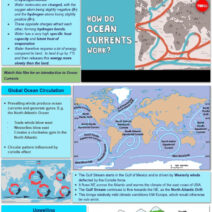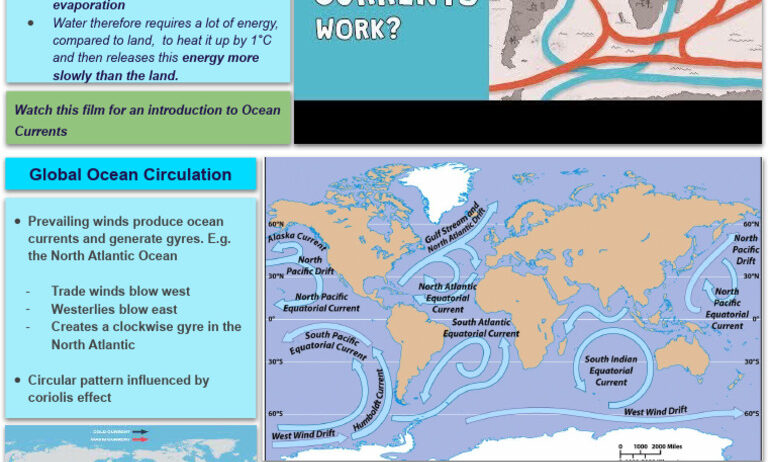The climate of the ocean is an intricate tapestry woven from myriad factors, each contributing to the contemporary condition of Earth’s environment. This vast expanse of water, which covers over 70% of our planet, serves as a crucial player in regulating the climate. The ocean’s currents, both surface and deep, orchestrate a symphony of thermal distribution, nutrient transport, and carbon cycling that profoundly affects global weather patterns and ecosystems. Understanding these dynamics provides a critical lens through which to view our changing climate.
Ocean Circulation: The Heartbeat of Climate
At the very core of marine climate interactions lies ocean circulation, a complex system that includes both surface currents and the less-discussed deep currents, collectively known as ocean thermohaline circulation. This system predominantly operates on the principles of buoyancy and salinity, where variations in temperature and salt concentration drive the movement of seawater. Surface currents, influenced by wind patterns and the Earth’s rotation, circulate heat from the equatorial regions toward the poles. Conversely, deep currents function like deep rivers, flowing vast distances beneath the ocean’s surface.
One of the most prominent features of ocean circulation is the global conveyer belt, which is responsible for transporting warm water from the tropics to the poles and returning cold water back to the equator. This exchange is vital for nutrient replenishment, marine biodiversity, and weather stabilization across continents. For instance, the Gulf Stream, part of this conveyor, carries warm water across the Atlantic, significantly affecting the climate of Europe, rendering it milder compared to other regions at similar latitudes.
The Role of Deep Currents
Delving deeper into the complexities of ocean climate, we encounter deep currents, often overshadowed by their surface counterparts. Deep ocean currents are predominantly the result of thermohaline circulation, which is influenced by temperature and salinity gradients. These currents, moving slowly but steadily, are essential in regulating the planet’s temperatures, particularly in remote regions such as the Arctic and Antarctic. The sinking of cold, dense water in these polar areas initiates a deep-water formation process that fuels the global conveyor belt.
These currents also play a pivotal role in carbon sequestration and nutrient distribution, ensuring that life flourishes in the ocean’s depths. Upwelling zones, where deep currents rise to the surface, bring nutrients that sustain phytoplankton—key organisms that absorb carbon dioxide and produce oxygen, thereby counterbalancing the effects of climate change.
Climate Change Implications
As climatic conditions shift, the intricate balance of ocean currents faces unprecedented challenges. Increasing temperatures lead to alterations in salinity and density structures, destabilizing established patterns of circulation. This shifting paradigm could potentially trigger drastic changes in marine ecosystems, threatening biodiversity and making significant impacts on global weather systems.
For example, the warming Arctic region is causing instability within the polar ice caps. The melting ice not only contributes to rising sea levels but also alters salinity and temperature – factors that can propel changes in deep ocean currents. The consequential reduction in the strength of the Gulf Stream could lead to severe weather implications for Europe and North America, including colder winters and unpredictable storms.
Moreover, the acidification of oceans due to increased carbon dioxide absorption poses a dire threat to marine life, particularly organisms with calcium carbonate structures, such as corals and shellfish. The impact of diminished biological diversity in oceans could upend food webs and affect coastal communities reliant on fisheries for sustenance.
The Global Influence
The influence of ocean climate extends beyond geography—it permeates economic, social, and political realms. Changes in ocean currents and temperatures can alter fishing patterns, affecting food security for millions globally. Coastal economies, reliant on tourism and fisheries, could face upheaval as ecosystems shift or collapse due to climatic pressures.
Understanding the flow of deep currents is imperative for climate action and global policy formation. As nations grapple with the realities of climate change, recognizing the ocean’s role as a climate regulator could inspire collaborative conservation efforts and innovative solutions. Improved predictive models based on deep current dynamics may aid in making informed decisions that bolster resilience in coastal and island communities vulnerable to climate impacts.
A Call to Awareness and Action
In conclusion, the climate of the ocean is a multifaceted and pivotal element of the Earth’s environmental system. Deep currents wield a force that influences weather and climate on a global scale, dictating much more than mere temperature gradients. To bridge the gap between understanding and action, society must foster an awareness of the ocean’s intrinsic value. By encouraging ocean literacy, funding research, and promoting sustainable practices, we can work towards mitigating the effects of climate change and safeguarding the diverse ecosystems that thrive within our oceans. A shift in perspective regarding oceans may yet unveil answers to pressing challenges we face today, urging us to see the interconnectedness of life on Earth.
Recognizing the ocean as an integral ally in the fight against climate change is not only essential; it is a hopeful commitment to protecting our planet for future generations.







